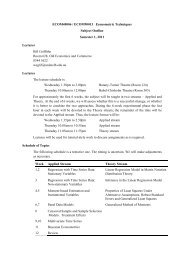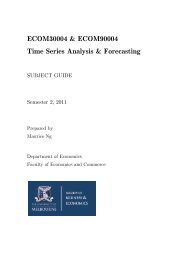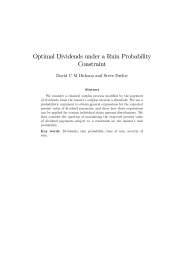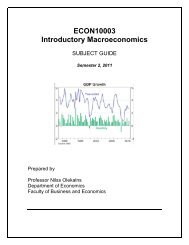A Model of Optimal Corporate Bailouts - Faculty of Business and ...
A Model of Optimal Corporate Bailouts - Faculty of Business and ...
A Model of Optimal Corporate Bailouts - Faculty of Business and ...
You also want an ePaper? Increase the reach of your titles
YUMPU automatically turns print PDFs into web optimized ePapers that Google loves.
expropriated in case <strong>of</strong> a bailout. This is the unremediable social moral hazard inducedby government intervention.Relative to non-intervention, both the owners <strong>and</strong> the incumbent managers are worse <strong>of</strong>f. Itis only the third party stakeholders that are better <strong>of</strong>f.Panel (A) shows that, as R increases, the government can tax less <strong>and</strong> less. Panel (B) showsthat corporate pr<strong>of</strong>its approach those in the absence <strong>of</strong> intervention. Note what happens at theborder where the government is indifferent between intervening <strong>and</strong> not intervening, becausethe firm is about to continue on without government intervention. Panel B shows that if themanager is not fired, her knowledge <strong>of</strong> the firm’s desire to restart makes her slack <strong>of</strong>f in thefirst period. This causes a discontinuity for the firm. Interestingly, if the firm could commititself not to restart so early, it would be better <strong>of</strong>f, because managers would work harder in thefirst period. (Of course, if the firm could simply fire the manager, as the government does incase <strong>of</strong> a bailout, then the firm does not face this moral-hazard problem, either.)4 ExtensionsOur base model made a number <strong>of</strong> simplifying assumptions in order to isolate key intuitions. Inthis section, we generalize that model through a number <strong>of</strong> extensions in order to illustrate therobustness <strong>of</strong> our key results.4.1 Heterogeneity <strong>of</strong> ManagersIn our basic model, the replacement manager was as effective as the incumbent manager (i.e.,the cost <strong>of</strong> effort, c, was equal). Theorem 1 showed that the government optimally fires a failedmanager, because the threat <strong>of</strong> termination increases managerial effort in the first stage. Inmany situations, this is a plausible assumption, because failure may in itself be associated with(<strong>and</strong> indicate) that the original manager was not particularly good <strong>and</strong> thus not better than herpotential replacement.But we can also consider the case in which the new replacement manager (n) is not aseffective as the old incumbent manager (o), i.e., c n > c o . The firm now faces a trade<strong>of</strong>f. Thethreat <strong>of</strong> termination upon failure still improves the incumbent’s incentives in the first stage.But this needs to be weighed against the lower continuation value in the second stage—with herhigher cost <strong>of</strong> effort, the replacement will optimally work less. We now examine the conditionsunder which the government can <strong>and</strong> will want to commit 21 ex ante to firing failed managers.Complicating the social welfare trade<strong>of</strong>f is the fact that when c n > c o , the bailout accompanyingmanagerial replacement (g n ) exceeds the bailout accompanying managerial retention (g o ).21 With lower effort from the replacement, it is no longer time-consistent to fire the incumbent. Thus, we nowhave to assume an ability to commit.23
















